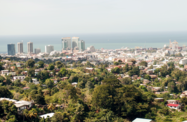 What steps are being taken to improve the ease of doing business in Guyana?
What steps are being taken to improve the ease of doing business in Guyana?
GASKIN: Following the publication of the 2016 “Doing Business” report, we contacted the World Bank to see which measures could be implemented to make an immediate difference in the next edition.
The World Bank provided us with helpful information and technical assistance to improve Guyana’s performance in specific areas of the report. A team visited us and held discussions with the government, certain agencies and the private sector.
As a result, we are now implementing a Doing Business action plan outlining reforms to address all of the indicators where Guyana scored badly. We’ve already partnered with three consultancies that have conducted studies and made recommendations for legislative reform, implementation of ICT in the public sector, and the efficient processing of electricity and construction permits.
Guyana has since improved 16 places in the index, from 140th to 124th out of 189 countries surveyed in the last report, and we are working actively and deliberately to continue along this trajectory. Over the next few years investors will see significant improvements as a result of our systematic strategy to address key issues affecting the ease of doing business in Guyana.
Last year we focused on improving access to electricity and credit, resulting in a major contribution to the overall score improvement. We are now developing a single electronic window for the processing of trade transactions in 2017, with implementation by late 2018.
Which sectors are being prioritised for investment by the Guyanese government?
GASKIN: Priority sectors for investment are agriculture, agro-processing, manufacturing and tourism. Our focus is on developing our value-added potential. We have a comparative advantage in the agriculture and agro-processing sector, given the size of Guyana coupled with its small population, as well as access to the Brazilian and Caribbean markets at favourable or zero tariff rates.
We will also be developing an export promotion strategy tying in with the investment opportunities inherent in some of the bilateral and international trade agreements we have signed. The Economic Partnership Agreement between the EU and the Caribbean has not been fully exploited by Guyana or most of the Caribbean region.
Additionally, we have a strong tourism product, but we need large-scale investments to develop our tourism infrastructure, expand accommodation offerings and provide increased airlift. Currently, we have 600-700 rooms that meet a three-to-five-star standard. This is insufficient for an emerging destination.
While there is some excitement about the recent oil discovery, we continue to focus on the development of a diversified economy that does not leave us vulnerable to the fortunes of a single commodity or industry. The oil sector will take on a life of its own, and we certainly want to support it, but we cannot allow it to subsume all economic activity in the country.
To what extent is the Guyanese government pursuing a public-private partnership (PPP) model for the development of its infrastructure?
GASKIN: We need to accelerate our infrastructure development in energy, transportation and telecommunications, as it affects our competitiveness and attractiveness as an investment destination. The public Treasury cannot fund it all; therefore, the PPP model is something we want to explore, since we recognise the availability of expertise, technology and capital within the private sector.
However, the absence of a framework to regulate PPPs needs to be addressed for this mechanism to be effectively utilised. While we pursue technical assistance in developing this framework, we still need to pursue certain critical projects, and in this regard we are interested in partnering with private entities with the requisite expertise and finances, and once we have a clear portfolio of investment projects, we will be pursuing partners to develop them.
What role will renewable energy have in Guyana’s future energy mix? How is investment being incentivised?
GASKIN: We have made a commitment that 100% of our electricity generation will be from renewable energy by 2025. Achieving this target will require significant investment within the power generation sector, whether it is constructing hydro plants, wind turbines or solar farms.
We cannot rely on standard incentives alone, since any agreement with a private partner for the generation of renewable energy will involve certain guarantees to both parties, which will impact the return on investment much more than mere tax concessions. We therefore need to rely on a robust PPP framework to attract the right investors.
Hydroelectricity has the greatest potential for large-scale renewable energy generation in Guyana. Given Guyana's relatively small demand, we have to look beyond our own borders for demand levels that would make such an investment viable. Energy integration within Latin America is an evolving phenomenon that Guyana cannot ignore, and we are exploring the opportunities presented by rising energy demand in the wider region.

 What steps are being taken to improve the ease of doing business in Guyana?
What steps are being taken to improve the ease of doing business in Guyana?